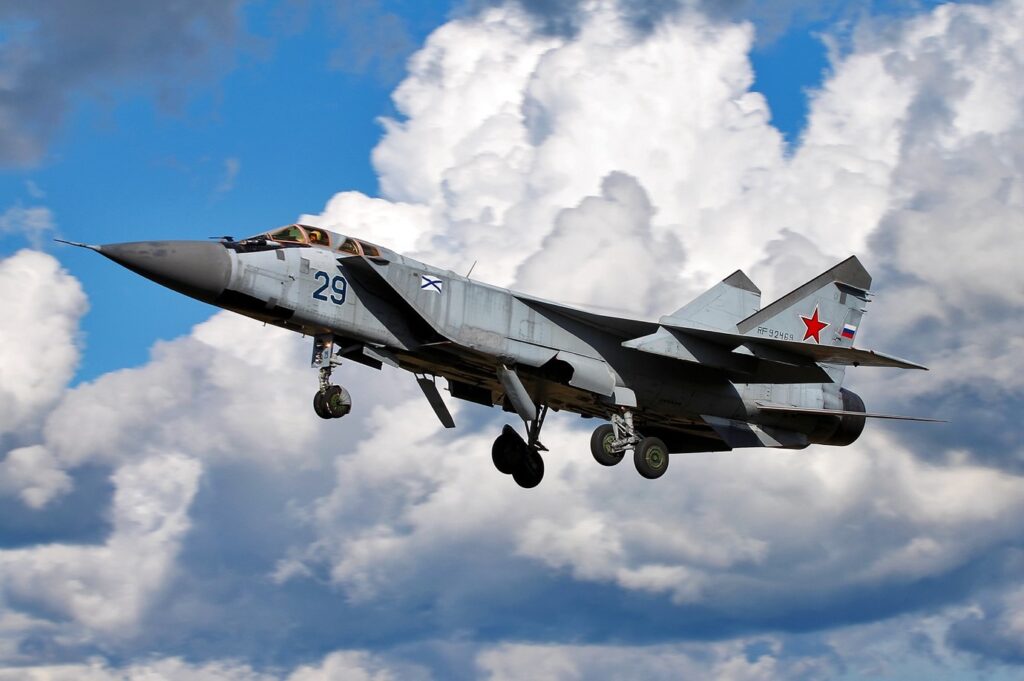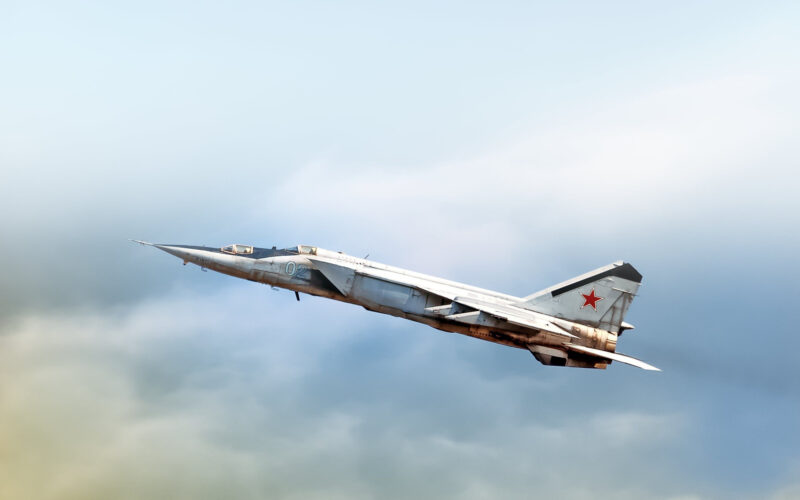During the 1960s, the Mikoyan and Gurevich Design Bureau, ‘MiG’, was looking to design a new aircraft to meet the particular requirements of the Soviet Air Defense Forces: be the fastest armed combat aircraft to counter the threat of the North American XB-70 Valkyrie strategic bomber.
The moniker ‘Foxbat’ was coined by James W. Doyle, a performance analyst from the US Air Force, to describe the MiG-25’s seemingly mystical capabilities at the time.
The first MiG-25 prototype flew in 1964 and the type entered service in 1970.
Its development was driven by the perceived threat of American high-altitude reconnaissance aircraft like the XB-70 and SR-71, which were capable of flying at altitudes well beyond the reach of Soviet interceptors of the time. As such, the MiG-25 was purposely designed to be a high-speed, high-altitude interceptor capable of intercepting and shooting down these types of aircraft.
Design of MiG-25
The design of the MiG-25 hinged on two primary characteristics: speed and altitude.
To achieve these performance capabilities, the aircraft was fitted with a large wing area and powerful engines. The wings were swept back at an angle of approximately 40 degrees to reduce drag and improve high-speed performance. The engines used on the MiG-25 were Tumansky R-15 turbojets, which produced a combined thrust of over 33,000 pounds force, enabling the aircraft to reach up to Mach 2.8, the maximum speed that it could sustain without damage.

One of the most distinctive features of the MiG-25’s design was its long, pointed nose section. This was due to the aircraft’s primary role as an interceptor, whereby it needed to be able to detect and engage enemy aircraft from a distance. The nose of the MiG-25 housed the aircraft’s radar system, which was capable of detecting enemy aircraft at ranges up to 75 miles.

The MiG-25’s design also incorporated several features to improve its survivability in combat. The aircraft was equipped with four air-to-air missiles and a single 23mm cannon for self-defense. It also featured a high degree of armour protection for the pilot and its engines were designed to be resistant to damage from enemy fire.
Performance
The MiG-25’s performance capabilities were truly impressive for its time. With a top speed of Mach 2.8, it ranked as the world’s second-fastest aircraft, following the SR-71 Blackbird, and not including rocket-powered aircraft the North American X-15.
MiG-25’s ceiling of 67,000 feet allowed it to operate at high altitudes beyond the reach of most other aircraft. However, the MiG-25’s range was limited due to its high fuel consumption at high speeds. Its combat radius was only around 186 miles, which made it less effective for long-range missions.
The MiG-25 also had some limitations in terms of its maneuverability. Its large size and weight made it less agile than some other aircraft, and its high-speed performance came at the cost of stability at lower speeds. These limitations were largely due to the aircraft’s primary role as an interceptor, rather than a dogfighter.
| Key specifications | |
| Manufacturer | Mikoyan-Gurevich |
| First Flight | 1964 |
| Current Operators | The last 2 operators are the Syrian Air Force and Libya Dawn (2 aircraft left for each) |
| Variants | 25 |
| Crew | 1 |
| Powerplants | 2 × Tumansky R-15BD-300 turbojets, 11,110 kgf each |
| Range | 1,860 km (1,160 miles) at Mach 0.9 1, 630 km (1,013 miles) at Mach 2.35 |
| Cockpit | Pressure-sealed |
| Shape | Pointed nose, slender body, and swept-back wings |
| Materials | 80% nickel-steel alloy, 11% aluminium, and 9% titanium |
| Dimensions | |
| Length | 78 feet 2 inches (23.82 meters) |
| Wingspan | 46 feet (14.01 meters) |
| Height | 20 feet (6.1 meters) |
| Weight (empty) | 44,092 pounds (20,000 kg) |
| Weight (max) | 81,000 pounds (36,720 kg) |
Military applications of MiG-25 Foxbat
The MiG-25’s military applications were primarily focused on air defense and reconnaissance. Its speed and altitude capabilities made it a formidable opponent for any potential enemy aircraft, and it was used extensively in the Soviet Union’s air defense network during the Cold War. In addition to its interceptor role, the MiG-25 was also equipped with powerful cameras and sensors for reconnaissance missions.
One of the MiG-25’s most notable military applications occurred during the Persian Gulf War, where Iraqi pilots flew the aircraft on several reconnaissance missions over Kuwait and Saudi Arabia. The MiG-25’s speed and altitude capabilities made it difficult to track with conventional radar systems, and it was able to gather valuable intelligence on enemy troop movements and military installations.
Despite its success in the Gulf War, the MiG-25’s limitations became increasingly apparent in the years that followed. Its high-speed performance made it difficult to maneuver, and its limited range and reliance on ground control meant that it was vulnerable to modern air defence systems. The MiG-25 was gradually phased out of service in most countries by the late 1990s, as newer and more advanced aircraft became available, such as the MiG-31 and Su-27.

Defection’s aftermath
In 1976, a Soviet Air Force pilot named Viktor Belenk was visiting Japan, having been assigned to participate in a joint Soviet-Japanese aviation exchange program. However, while in the country Belenko defected to Japan, complete with a MiG-25.
This allowed Western intelligence agencies to examine the aircraft up close and revealed that many of the previous assumptions about its capabilities were inaccurate. For example, it was believed that the MiG-25 was extremely maneuverable but, it was built for speed at the expense of agility.
Belenko’s defection provided valuable intelligence to the West and the MiG-25 was no longer viewed as an invincible threat. Nevertheless, the aircraft remained in service for many years with the Soviet Union, amongst other countries, before eventually being succeeded by newer aircraft designs.
In the Soviet Union, the MiG-25 was followed by the Mikoyan MiG-31, which entered service in the late 1970s. The MiG-31 was also an interceptor aircraft, but it had many improvements over its predecessor, including more advanced radar and avionics, better engines, and improved maneuverability.
Other countries created their own aircraft to counter the MiG-25 threat. For example, the United States developed the F-15 Eagle and F-14 Tomcat, both of which were designed to counter Soviet aircraft such as the MiG-25. These aircraft were also used for other purposes, such as air superiority and ground attack.

MiG -25’s legacy lives on
Despite having been retired from service in most countries, the Mikoyan-Gurevich MiG-25 continues to live on as a symbol of Cold War-era aviation technology. Its impressive speed and altitude capabilities continue to inspire awe and its distinctive design has made it a popular subject for aviation enthusiasts and model makers alike.
In addition to its military applications, the MiG-25 also played a role in the development of civilian aviation technology. The aircraft’s high-speed performance and ability to operate at high altitudes were instrumental in the development of the Concorde supersonic passenger jet, which made its first flight in 1976, just a few years after the MiG-25.
Watch how MiG-25 Foxbat once terrified the West:

